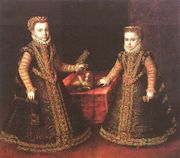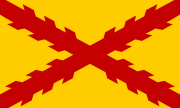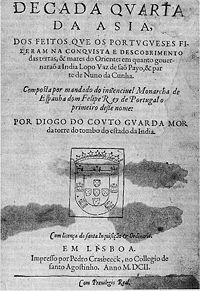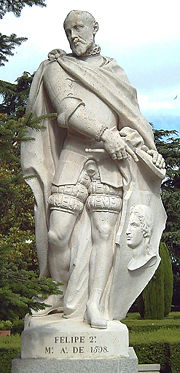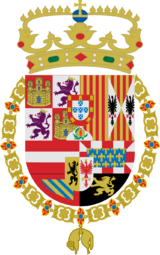Philip II of Spain
2008/9 Schools Wikipedia Selection. Related subjects: Historical figures
| Philip II | |
| King of Spain and Portugal, King of Naples, Ruler of the Spanish Netherlands, Duke of Milan | |
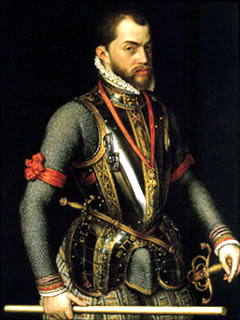 |
|
| Reign | January 16, 1556– September 13, 1598 |
|---|---|
| Born | May 21, 1527 |
| Birthplace | Valladolid, Spain |
| Died | September 13, 1598 (aged 71) |
| Place of death | Madrid, Spain |
| Predecessor | Charles I of Spain (Spain) Cardinal Henry of Portugal (Portugal) Anthony, Prior of Crato (Portugal, disputed) |
| Successor | Philip III of Spain |
| Consort | Mary of Portugal Mary I of England Elizabeth of Valois Anna of Austria |
| Offspring | Don Carlos, Prince of Asturias Isabella Clara Eugenia Catalina Micaela Philip III of Spain |
| Royal House | House of Habsburg |
| Father | Charles V, Holy Roman Emperor |
| Mother | Isabella of Portugal |
Philip II (Spanish: Felipe II de España; Portuguese: Filipe I) ( May 21, 1527 – September 13, 1598) was King of Spain from 1556 until 1598, King of Naples from 1554 until 1598, king consort of England (as husband of Mary I) from 1554 to 1558, Lord of the Seventeen Provinces (holding various titles for the individual territories, such as Duke or Count) from 1556 until 1581, King of Portugal and the Algarves (as Philip I) from 1580 until 1598 and King of Chile from 1554 until 1556.
Philip's reputation has been the subject of almost continuous historical debate. During his time the Spanish Empire led global exploration and colonial expansion across the Atlantic and the Pacific, becoming for a long time the foremost European and global power.
Economy
Charles V had left Philip with a debt of 36 million ducats and an annual deficit of 1 million ducats. Aside from reducing state revenues for overseas expeditions, the domestic policies of Philip II further burdened Spain, and would, in the following century, contribute to its decline.
Spain was subject to separate assemblies: the Cortes in Castile along with the assembly in Navarre and three for each of the three regions of Aragon, each of which guarded their traditional rights and laws inherited when they were separate kingdoms. This made Spain and its possessions difficult to rule. However, while France was divided by regional states, it had a single Estates-General. The lack of a viable supreme assembly would lead to power being concentrated in Philip's hands, but this was made necessary by the constant conflict between different authorities that required his direct intervention as the final arbiter. To deal with the difficulties arising from this situation authority was administered by local agents appointed by the crown and viceroys carrying-out crown instructions. Philip, felt it necessary to be involved in the detail and presided over specialized councils for state affairs, finance, war, and the Inquisition. He played royal bureaucrats against each other, leading to a system of checks and balances that managed state affairs in an inefficient manner, sometimes damaging state business, such as the Perez affair. Calls to move the capital to Lisbon from the Castilian stronghold of Madrid — the new capital Philip established following the move from Valladolid — could have led to a degree of decentralization, but Philip opposed such efforts. Due to the inefficiencies of the Spanish state, industry was overburdened by government regulations, though this was common to many contemporary countries. The dispersal of the Moriscos from Granada - motivated by the fear they might support a Muslim invasion - had serious negative economic effects, particularly in that region.
Philip's regime neglected arable farming in favour of sheep ranching, thus forcing Spain to import large amounts of grain and other foods by the mid-1560s. Overseeing a divided conservative class structure, the Church and the upper classes were exempt from normal taxation (although the wealthy usually paid tithes to the Church, and the Church and clergy were often taxed, usually following a series of agreements with the Pope) while the tax burden fell disproportionately on the classes engaged in trade, commerce, and industry.
Inflation throughout Europe in the sixteenth century was a broad and complex phenomenon, with the flood of bullion from the Americas arguably being the main cause of it in Spain, along with population growth, and government spending. Under Philip's reign, Spain saw a fivefold increase in prices. Due to inflation and a high tax burden for Spanish manufacturers and merchants, Spanish industry was harmed and much of Spain’s wealth was spent on imported manufactured goods by an opulent, status-oriented aristocracy and wars. Increasingly the country became dependent on the revenues flowing in from the mercantile empire in the Americas, leading to Spain's first bankruptcy ( moratorium) in 1557 due to rising military costs. Dependent on sales taxes from Castile and the Netherlands, Spain's tax base, was too narrow to support Philip's plans. Philip became increasingly dependent on loans from foreign bankers, particularly in Genoa and Augsburg. By the end of his reign, interest payments on these loans alone accounted for 40% of state revenue.
Ottoman-Habsburg Conflict
In the early part of his reign, Philip was concerned with the rising power of the Ottoman Empire under Suleiman the Magnificent. Fear of Islamic domination in the Mediterranean caused him to pursue an aggressive foreign policy.
In 1558 Turkish admiral Piyale Pasha captured the Balearic Islands, especially inflicting great damage on Minorca and enslaving many, while raiding the coasts of the Spanish mainland. Philip appealed to the Pope and other powers in Europe to bring an end to the rising Ottoman threat. Since his father's losses against the Ottomans and against Barbarossa Hayreddin Pasha in 1541, the major European sea powers in the Mediterranean, namely Spain and Venice, became hesitant in confronting the Ottomans. The myth of "Turkish invincibility" was becoming a popular story, causing fear and panic among the people.
In 1560 Philip II organized a Holy League between Spain and the Republic of Venice, the Republic of Genoa, the Papal States, the Duchy of Savoy and the Knights of Malta. The joint fleet was assembled at Messina and consisted of 200 ships (60 galleys and 140 other vessels) carrying a total of 30,000 soldiers under the command of Giovanni Andrea Doria, nephew of the famous Genoese admiral Andrea Doria who had lost three major battles against the Turks in 1538, 1541 and 1552.
On March 12, 1560, the Holy League captured the island of Djerba which had a strategic location and could control the sea routes between Algiers and Tripoli. As a response, Suleiman the Magnificent sent an Ottoman fleet of 120 ships under the command of Piyale Pasha, which arrived at Djerba on May 9, 1560. The battle lasted until May 14, 1560, and the forces of Piyale Pasha and Turgut Reis (who joined Piyale Pasha on the third day of the battle) had an overwhelming victory at the Battle of Djerba. The Holy League lost 60 ships (30 galleys) and 20,000 men, and Giovanni Andrea Doria could barely escape with a small vessel. The Ottomans retook the Fortress of Djerba, whose Spanish commander, D. Alvaro de Sande, attempted to escape with a ship but was followed and eventually captured by Turgut Reis. In 1565 the Ottomans sent a large expedition to Malta, which laid siege to several forts on the island, taking some of them. The Spanish sent a relief force, which drove the Ottomans, exhausted from a long siege, away from the island.
The grave threat posed by the increasing Ottoman domination of the Mediterranean was reversed in one of history's most decisive battles, with the destruction of nearly the entire Ottoman fleet at the Battle of Lepanto in 1571, by the Holy League under the command of Philip's half brother, Don Juan of Austria. A fleet sent by Philip, again commanded by Don John, reconquered Tunis from the Ottomans in 1573. However, the Turks soon rebuilt their fleet and in 1574 Uluç Ali Reis managed to recapture Tunis with a force of 250 galleys and a siege which lasted 40 days. However Lepanto marked a permanent reversal in the balance of naval power in the Mediterranean and the end of the threat of complete Ottoman control of that sea.
In 1585 a peace treaty was signed with the Ottomans.
Revolt in the Netherlands
Philip's rule in the seventeen separate provinces known collectively as the Netherlands faced many difficulties, which led to open warfare in 1572. Philip insisted on direct control over events in the Netherlands despite being over a fortnights ride away in Madrid. There was discontent in the Netherlands about Philip's taxation demands. In 1566 Protestant preachers sparked off anti-clerical riots known as the Iconoclast Fury; in response to growing 'heresy' the Duke of Alba's army invaded, further alienating the local aristocracy. In 1572 a prominent member of Dutch aristocracy, William the Silent invaded the Netherlands, but only succeeded in holding two provinces, Holland and Zeeland. The States-General of the Dutch provinces, united in the 1579 Union of Utrecht, passed an Act of Abjuration, meaning that they no longer recognised Philip their king. The southern Netherlands (what is now Belgium) remained under Spanish rule. The rebel leader, Prince of Orange (William the Silent) was assassinated in 1584 by Balthasar Gérard, after Philip had offered a reward of 25,000 crowns to anyone who killed William the Silent, calling him a 'pest on the whole of Christianity and the enemy of the human race'. The Dutch forces continued to fight on under Orange's son Maurice of Nassau, who received help from Queen Elizabeth I in 1585. The Dutch gained an advantage over Spanish due to their growning economic strength, in contrast to Philip's burgeoning economic troubles.
King of Portugal
Philip became King of Portugal in 1581, when he was crowned as Philip I of Portugal and was recognized as such by the Cortes of Tomar.
In 1580, the direct line of the Portuguese royal family had ended when Sebastian of Portugal died following a disastrous campaign in Morocco. Philip spoke Portuguese mostly until his mother died. His power helped him to seize the throne, which would be kept as a personal union for sixty years.
Philip famously remarked upon his acquisition of the Portuguese throne: "I inherited, I bought, I conquered", a variation on Julius Caesar and Veni, Vidi, Vici. Thus, Philip added to his possessions a vast overseas empire in Africa, Brazil, and the East Indies, seeing a flood of new revenues coming to the Habsburg crown; and the success of colonizing all around his empire improved his financial position, enabling him to show greater aggression towards his enemies.
War with England
Spanish hegemony and the Counter-Reformation achieved a clear boost in 1554, when Philip married Queen Mary, a Catholic, the older daughter of Henry VIII, and his father's first cousin. However, they had no children; Queen Mary, or "Bloody Mary" as she came to be known in English Protestant lore, died in 1558 before the union could revitalize the Catholic Church in England.
The throne went to Elizabeth, the Protestant daughter of Henry VIII and Anne Boleyn. This union was deemed illegitimate by English Catholics, who did not recognize divorce and who claimed that Mary, Queen of Scots, the Catholic great-granddaughter of Henry VII, was the legitimate heir to the throne.
The execution of Mary, Queen of Scots, in 1587 ended Philip's hopes of placing a Catholic on the English throne. He turned instead to more direct plans to return England to Catholicism by invasion. His opportunity came when England provided support for the Dutch rebels. In 1588 he sent a fleet of vessels, the Spanish Armada, to lead an invasion. The fact that the Spanish fleet had no deep bay in which it could deploy its main fleet meant that it was unable to land and was vulnerable to the smaller English ships. The absence of a backup from the troop carrying ships that were unable to link up with the Armada meant that they were isolated and open to the English fire ships and close range artillery. It was by no means a slaughter; it was a tightly fought battle, but the Spanish were caught in an awkward position and were forced back into retreat. Nonetheless, the operation had little chance of success from the beginning with huge delays, lack of communication between Philip II and his two commanders and of course the obvious lack of a deep bay. Eventually, three more Armadas were deployed; two were sent to England ( 1596 and 1597), both of which also failed; the third (1599) was diverted to the Azores and Canary Islands to fend off raids there. This Anglo-Spanish war (1585-1604) would be fought to a grinding end, but not until both Philip II (d. 1598) and Elizabeth I (d. 1603) were dead.
The stunning defeat of the Spanish Armada gave great heart to the Protestant cause across Europe. The storm that smashed the retreating armada was seen by many of Philip's enemies as a sign of the will of God. Many Spaniards blamed the admiral of the armada for its failure, but Philip, despite his complaint that he had sent his ships to fight the English, not the elements, was not among them. A little over a year later, in a chat with a monk working in his garden, Philip remarked that:
| “ | "It is impiety, and almost blasphemy to presume to know the will of God. It comes from the sin of pride, Even kings, Brother Nicholas, must submit to being used by God's will without knowing what it is. They must never seek to use it." | ” |
The Spanish navy was rebuilt, and intelligence networks were improved. An example of the character of Philip II can be given by the fact that he personally saw that the wounded of the Armada were treated and received a pension, which was unusual for the time.
While the invasion had been averted, England was unable to take advantage of this success. An attempt to use her newfound advantage at sea with a counter armada the following year failed disastrously. Likewise, English buccaneering and attempts to seize territories in the Caribbean were defeated by Spain's rebuilt navy and her intelligence networks (although Cadiz was destroyed by an Anglo-Dutch force after a failed attempt to seize the treasure fleet.)
Even though Philip was bankrupt by 1596 (for the fourth time, after France had declared war on Spain), in the last decade of his life more silver and gold were shipped safely to Spain than ever before. This allowed Spain to continue its military efforts, but led to an increased dependency on the precious metals.
War with France
From 1590 to 1598 Philip was also at war against Henry IV of France, joining with the Papacy and the Duke of Guise in the Catholic League during the French Wars of Religion. Philip's interventions in the fighting - sending Alessandro Farnese, Duke of Parma to relieve the siege of Paris in 1590 – and again into Rouen in 1592 - to aid the Catholic faction, resulted in refortifying the French defenses. Henry IV of France was also able to use his propagandists to identify the Catholic faction with a foreign enemy (Philip and Spain). In 1593, Henry agreed to convert to Catholicism; this caused most French Catholics to rally to his side against the Spanish forces. In June 1595 the redoubtable French king defeated the Spanish-supported Holy League in Fontaine-Française in Burgundy and reconquered Amiens from the overstretched Spanish forces in September 1597. The 1598 Treaty of Vervins was largely a restatement of the 1559 Peace of Câteau-Cambrésis; meanwhile, Henry issued the Edict of Nantes, which offered a high degree of religious toleration for French Protestants. The military intervention in France thus ended in a disappointing fashion for Philip, as it failed to either oust Henry from the throne or suppress Protestantism in France. However, the conversion of Henry ensured that Catholicism would remain France's majority faith.
Legacy
Under Philip II Spain reached the peak of its power but also met its limits. Having nearly reconquered the rebellious Netherlands, Philip's unyielding attitude led to their loss, this time permanently, as his wars expanded in scope and complexity. So in spite of the great and increasing quantities of gold and silver flowing into his coffers from the American mines, the riches of the Portuguese spice trade and the enthusiastic support of the Habsburg dominions for the Counter-Reformation, he would never succeed in suppressing Protestantism or defeating the Dutch rebellion. Early in his reign the Dutch might have laid down their weapons if he had desisted in trying to suppress Protestantism, but his devotion to Roman Catholicism and the principle of cuius regio, eius religio, as laid down by his father, would not permit him. He was a fervent Roman Catholic, and exhibited the typical 16th century disdain for religious heterodoxy.
One of the long term consequences of his striving to enforce Catholic orthodoxy through an intensification of the Inquisition was the gradual smothering of Spain's intellectual life. Students were barred from studying elsewhere and books printed by Spaniards outside the kingdom were banned. Even a highly respected churchman like Archbishop Carranza, was jailed by the Inquisition for seventeen years merely for ideas that seemed sympathetic in some degree to Protestant reformism. Such strict enforcement of orthodox belief was successful and Spain avoided the religiously inspired strife tearing apart other European dominions, but this came at a heavy price in the long run, as her great academic institutions were reduced to third rate status under Philip's successors.
However, Philip II's reign can hardly be characterized as a failure. He consolidated Spain's overseas empire, succeeded in massively increasing the importation of silver in the face of English, Dutch and French privateering, and ended the major threat posed to Europe by the Ottoman navy (though peripheral clashes would be ongoing). He succeeded in uniting Portugal and Spain through personal union. He dealt successfully with a crisis that could have led to the secession of Aragon. His efforts also contributed substantially to the success of the Catholic Counter-Reformation in checking the religious tide of Protestantism in Northern Europe. Philip was a complex man, and though given to suspicion of members of his court, was not the cruel tyrant that he has been painted by his opponents. Philip was known to intervene personally on behalf of the humblest of his subjects. Above all a man of duty, he was also trapped by it.
Anglo-American societies have generally held a very low opinion of Philip II. The traditional approach is perhaps epitomized by James Johonnot's Ten Great Events in History, in which he describes Philip II as a "vain, bigoted, and ambitious" monarch who "had no scruples in regard to means... placed freedom of thought under a ban, and put an end to the intellectual progress of the country" Spanish apologists generally classify this analysis as part of the Black Legend.
The defense of the Roman Catholic Church and the defeat and destruction of the Protestantism was one of his most important goals. He didn't totally accomplish this; England broke with Rome after the death of Mary, the Holy Roman Empire remained partly Protestant and the revolt in Holland continued. Nevertheless, he prevented Protestantism from gaining a grip in Spain and Portugal and the colonies in the New World, successfully reimposed Catholicism in the reconquered southern half of the Low Countries and forced the French monarchy to abandon Protestantism.
Philip II died in 1598 due to an unspecified type of cancer in El Escorial, (near Madrid) and was succeeded by his son, King Philip III. The Philippines, a former Spanish colony was named in his honour.
Ancestors
|
||||||||||||||||||||||||||||||
|
|
|
|
|
|
|
|
|
|
|
|
|
|
|
|
|
|
|
|
16. Frederick III, Holy Roman Emperor | |||||||||||||||
|
|
||||||||||||||||
|
|
|
|
|
|
||||||||||||
|
|
8. Maximilian I, Holy Roman Emperor |
|
||||||||||||||
|
|
||||||||||||||||
|
|
|
|
|
|
|
|
|
|||||||||
|
|
17. Eleanor of Portugal | |||||||||||||||
|
|
||||||||||||||||
|
|
|
|
|
|
||||||||||||
|
|
4. Philip I of Castile |
|
||||||||||||||
|
|
||||||||||||||||
|
|
|
|
|
|
|
|
|
|
|
|
||||||
|
|
18. Charles, Duke of Burgundy | |||||||||||||||
|
|
||||||||||||||||
|
|
|
|
|
|
||||||||||||
|
|
9. Mary of Burgundy |
|
||||||||||||||
|
|
||||||||||||||||
|
|
|
|
|
|
|
|
|
|||||||||
|
|
19. Isabella of Bourbon | |||||||||||||||
|
|
||||||||||||||||
|
|
|
|
|
|
||||||||||||
|
|
2. Charles V, Holy Roman Emperor |
|
||||||||||||||
|
|
||||||||||||||||
|
|
|
|
|
|
|
|
|
|
|
|
|
|
|
|||
|
|
20. John II of Aragon | |||||||||||||||
|
|
||||||||||||||||
|
|
|
|
|
|
||||||||||||
|
|
10. Ferdinand II of Aragon |
|
||||||||||||||
|
|
||||||||||||||||
|
|
|
|
|
|
|
|
|
|||||||||
|
|
21. Juana Enriquez | |||||||||||||||
|
|
||||||||||||||||
|
|
|
|
|
|
||||||||||||
|
|
5. Joanna of Castile |
|
||||||||||||||
|
|
||||||||||||||||
|
|
|
|
|
|
|
|
|
|
|
|
||||||
|
|
22. John II of Castile | |||||||||||||||
|
|
||||||||||||||||
|
|
|
|
|
|
||||||||||||
|
|
11. Isabella I of Castile |
|
||||||||||||||
|
|
||||||||||||||||
|
|
|
|
|
|
|
|
|
|||||||||
|
|
23. Isabel of Portugal | |||||||||||||||
|
|
||||||||||||||||
|
|
|
|
|
|
||||||||||||
|
|
1. Philip II of Spain |
|
||||||||||||||
|
|
||||||||||||||||
|
|
|
|
|
|
|
|
|
|
|
|
|
|
|
|
|
|
|
|
24. Edward of Portugal | |||||||||||||||
|
|
||||||||||||||||
|
|
|
|
|
|
||||||||||||
|
|
12. Infante Fernando, Duke of Viseu |
|
||||||||||||||
|
|
||||||||||||||||
|
|
|
|
|
|
|
|
|
|||||||||
|
|
25. Leonor of Aragon | |||||||||||||||
|
|
||||||||||||||||
|
|
|
|
|
|
||||||||||||
|
|
6. Manuel I of Portugal |
|
||||||||||||||
|
|
||||||||||||||||
|
|
|
|
|
|
|
|
|
|
|
|
||||||
|
|
26. Infante João, Lord of Reguengos | |||||||||||||||
|
|
||||||||||||||||
|
|
|
|
|
|
||||||||||||
|
|
13. Beatriz of Portugal |
|
||||||||||||||
|
|
||||||||||||||||
|
|
|
|
|
|
|
|
|
|||||||||
|
|
27. Ferdinand I of Portugal | |||||||||||||||
|
|
||||||||||||||||
|
|
|
|
|
|
||||||||||||
|
|
3. Isabella of Spain |
|
||||||||||||||
|
|
||||||||||||||||
|
|
|
|
|
|
|
|
|
|
|
|
|
|
|
|||
|
|
28. John II of Aragon (= 20) | |||||||||||||||
|
|
||||||||||||||||
|
|
|
|
|
|
||||||||||||
|
|
14. Ferdinand II of Aragon (= 10) |
|
||||||||||||||
|
|
||||||||||||||||
|
|
|
|
|
|
|
|
|
|||||||||
|
|
29. Juana Enriquez (= 21) | |||||||||||||||
|
|
||||||||||||||||
|
|
|
|
|
|
||||||||||||
|
|
7. Maria of Aragon |
|
||||||||||||||
|
|
||||||||||||||||
|
|
|
|
|
|
|
|
|
|
|
|
||||||
|
|
30. John II of Castile (= 22) | |||||||||||||||
|
|
||||||||||||||||
|
|
|
|
|
|
||||||||||||
|
|
15. Isabella I of Castile (= 11) |
|
||||||||||||||
|
|
||||||||||||||||
|
|
|
|
|
|
|
|
|
|||||||||
|
|
31. Isabel of Portugal (= 23) | |||||||||||||||
|
|
||||||||||||||||
|
|
|
|
|
|
||||||||||||
Family
Philip in fiction
Philip II is a central character in Friedrich Schiller's play Don Carlos and Giuseppe Verdi's operatic adaption of the same. He is depicted more sympathetically in the opera than in the play. Philip II is one of the greatest roles for bass in opera and Verdi composed one of his greatest arias, "Ella giammai m'amó!", for the character.
Charles de Coster's 1867 The Legend of Thyl Ulenspiegel and Lamme Goedzak, considered a masterpiece of 19th Century Belgian literature, depicts the Dutch War of Independence in an extremely partisan manner, though it was an event nearly three centuries old at the time of writing. Accordingly, Philip II is depicted as a total caricature, a vicious moron with not the slightest redeeming feature - a depiction seemingly drawing on hostile Dutch and other Protestant sources of Philip's own time.
Philip II is played by Jordi Molla in Shekhar Kapur's 2007 film Elizabeth: The Golden Age. He also appears in the opening scene of the 1940 adventure film The Sea Hawk and is played by Montagu Love. Philip's marriage to Elisabeth and the subsequent episode with his son are strongly alluded to in Lope de Vega's Castigo sin venganza (1631).
A good novelised account of Philip's personal life and character appears in The Spanish Bridegroom by Jean Plaidy. The plot of Carlos Fuentes's 1975 novel, Terra Nostra, revolves around the construction of Philip II's monastery/palace of San Lorenzo de El Escorial in the Sierra de Guadarrama near Madrid. Philip II also appears in Actus Fidei, a play by Steven Breese which premiered at Christopher Newport University in 2007.
In Philippa Gregory's The Queen's Fool, a historical novel set in the court of Mary I of England, Philip - Mary's consort at the time - is depicted as completely captivated by the seductive Princess Elizabeth (the future Queen Elizabeth I) even though "as a brilliant statesman and diplomat, he was well-aware that this fascination with his wife's sister was harmful to his political interests" as the book puts it.
In Harry Turtledove's alternate history novel Ruled Britannia, in which the Spanish Armada succeeded in its effort to conquer England, Shakespeare is engaged by the victorious Spanish to write a play glorifying King Philip.
A verse in G.K. Chesterton's Lepanto speaks of Philip engaging in a strange alchemical ritual.
